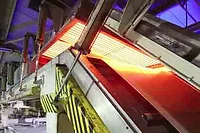Ink Production Plant Rebuilt to Improve Product Quality and Meet Environmental Regulations

Gravure printing has continually lost share in the printing market since the 1950s. Alternate technologies and, more recently, environmental demands have pressured ink makers to find new applications, new technologies and better processes. And in the last 10 years the industry has responded. But even these positive changes have put pressure on producers. Sun Chemical, the world’s largest producer of printing inks and pigments, was aware that it needed to continue to evolve with the changing industry to remain its leader.
In 2004, the company began the phased relocation of its publication gravure ink production from Watford, England, just outside of London, to the existing Sun Chemical Ltd., site in Rochdale, Lancashire, about 200 miles to the north. The company’s goal was a standalone publication gravure ink plant that would utilize all new equipment and production processes to generate 30,000 metric tons of ink per year. The plant’s design incorporated the latest process control technology, designated manufacturing and raw materials storage. It would operate five lines, one for each color, and a fifth line for varnishes and extenders. It also included a tank farm for storing liquid raw materials, intermediate products and finished inks.
Sun looked to outsource the role of principal contractor. The vendor would be responsible for plant design and construction, and would need to follow Construction, Design and Management (CDM) regulations while overseeing safe site operations during construction and testing phases.
Sun Chemical invited Netzsch-Mastermix Ltd. (UK) to participate in a trial. A team of Netzsch engineers and Sun Chemical technical staff tested prospective plant throughputs and efficiencies. Netzsch engineers then proposed a plan for a facility that met Sun Chemical’s guidelines for product quality, volume and yearly output. The plant would be capable of pigment milling 116 to 204 kilograms per hour, and the combined mill base outputs could reach 2300 kilograms per hour.
The Netzsch team would design and engineer the plant, specify equipment and manage the construction and plant start-up on a turnkey basis. It would also manage main site services and the installation and commissioning of all ancillary equipment. Acutely aware that time is money, Sun set a narrow 48-week timetable to go from completed plans all the way to live chemical trials.

Plant Design Challenges
Manufacturing high-quality publication gravure ink presents many challenges. For starters, materials used in the process have high solids concentrations at the grinding stage, making them viscous and difficult to pump. The toluene solvents used to produce the inks can be potentially hazardous to the environment, requiring a completely closed ink-production system. These were only two of the most obvious obstacles.So the two teams worked together to select suppliers based on their technical understanding of the products, the availability of service and backup support, ability to meet schedules and cost effectiveness. On-time delivery would play a key role in the overall timescale of the project. The team educated suppliers and provided them with installation and commissioning plans to emphasize the importance of scheduling.
The team selected a combination of machines – PMD (pre-mixer disperser) batch disperser technology, upgraded LME horizontal bead mills and a PSI-Mix inline disperser. Plant utilization was split between simple intermediate product production on PMD machines and ink production on the LME and PSI combination.
The LME horizontal bead mill allowed Sun to increase throughput rates with virtually no blockage. Its triple lobe disc actively counteracts product flow using a “triple screw” effect. Because temperatures can rise significantly when grinding very viscous materials, like those used in the publication gravure process, the large cooling surfaces of the LME mill protect the integrity of the product. By keeping temperatures down, the materials’ properties are not altered. A dynamic cartridge media separator pre-classifies beads 0.1 mm to 5 mm and centrifuges them away from the screen. This prevents compaction of the beads, resulting in high power draw and therefore high product temperature, which can degrade the resin in the ink and change the pigment shade.
The PSI mixer, an inline disperser, achieves homogeneous, fine dispersions using a controlled process. Netzsch was challenged to optimize the speed (rpm) of each PSI unit on each line to deal with the characteristic differences for each pigment. Black pigment, for instance, is hard to break down but easy to handle, while red is easier to process but difficult to handle. The combination of vacuum dispersing, shearing and pressure wetting proved successful, giving Sun excellent results and reproducible quality.
Additionally, a vacuum feeding system eliminated emissions-related hazards. The system has very low dust emission, reduces solvent emissions and the waste of solvents. It is environmentally friendly because it degasses during mixing in a totally closed system. Doing so helps the plant meet the United Kingdom’s ATEX directives for workplace health and safety. But the vacuum system also provides a production advantage: it disperses agglomerates so that each particle is encapsulated. This improves efficiency and total throughput.

Concept to Power-Up in 48 Weeks
With less than a year to have the plant up and running, Netzsch arrived at the site in October 2005 to supervise installation of the plant under CDM regulations. “We were on site for every hour of the construction to ensure that work was completed safely and on time,” said Scott Stephenson, Netzsch project manager. “We were responsible for the safety of up to 50 contractors working alongside each other.”The delivery and erection of the first mezzanine support steelwork occurred in stages that coincided with the arrival of 32 machines from the Netzsch production facility in Germany. Within eight weeks, steel was built around all of the Netzsch machinery.
At the same time, pipe work and the tank farm phases of the construction were underway. The installation of 21 bulk storage tanks with capacities ranging from 65,000 liters to 120,000 liters in two bounded areas – one for raw, the other for finished goods – went successfully.
By late December, the team completed positioning all major plant items and all materials necessary to complete the installation of the process plant, and ancillary services were on site. Within one month, workers installed internal pipe-work manifolds in sections, with the process valves, and erected interconnecting tank farm pipe work and supports.
In mid-March, operational staff arrived to assist in sequence checks and become familiar with the HMIs, control systems and general plant operation. The Sun Chemical/Netzsch team began power-up of the plant, running successful input/output (I/O), rotation and instrumentation checks.
After calibration and dry sequence checking, the team began using water to run wet testing on the miles of pipe work, valves, pumps and vessels. The team members’ extensive experience in hazardous atmospheres ensured safe operation at this testing phase. After every possible sequence was run and checked by both sides of operations staff, the pipe work and tanks were drained and prepped for product trials.
The team began product trials and plant start-up with solvents in early April 2006, and ramped up production on all four color lines, the resin plant and the additives plant to ensure production targets and guarantees. This continuous process led to full production and, eventually, product supply to final customers at the end of May 2006.
In the end, the results were significant and a vast improvement over Sun’s old Watford plant. The Rochdale plant produces blue and black pigments in 12-metric ton batches. Batch times are approximately 12 hours compared to 48 hours at the old facility. Seven-metric ton red and yellow pigment batches are completed in less than 5 hours compared to 7 hours in the Watford plant. And batch accuracy at Rochdale is now an impressive 0.001 percent.
“This investment is fundamental in ensuring Sun Chemical is aligned with the future growth of the Publication Gravure business,” said Sun Chemical’s managing director in charge of the UK in a press release issued by the company. “The new operation at Rochdale will re-enforce our commitment and leadership in this sector and cater to the growing re-emergence of Publication Gravure as a high-quality commercial printing process for the future.”
The UK-based NETZSCH Project Engineering team, assisted by German colleagues in machinery design and laboratory testing, brought together a turnkey plant of 32 machines and ancillaries on time and on budget. “Obviously we consider this project a success,” said David Tomlinson, managing director of NETZSCH-Mastermix Ltd. “One of the world’s largest ink producers entrusted us to design, engineer and construct a new plant with the latest technology, and it is running successfully today.” And now, almost two years since the plant opened, the Sun’s Rochdale location is guaranteed to produce more than 13,200 metric tons of ink per year, and is capable of producing 30,000 metric tons if operated at full capacity.
Looking for a reprint of this article?
From high-res PDFs to custom plaques, order your copy today!





